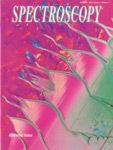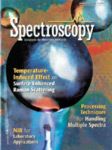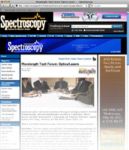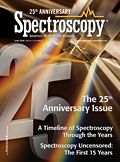Spectroscopy Moves into the Digital Age
Editor-in-Chief David Walsh discusses Spectroscopy's transition into the Digital Age.

Writing here in the same issue as two old-time Spectroscopy veterans is a daunting task indeed. I certainly do not have the industrywide technical perspective of Howard Mark, who has been in the field of spectroscopy for several decades, and who recently bragged of owning and having read every issue Spectroscopy has ever published (the only person I have met who can make such a claim). And I also do not have the insider's knowledge of those first issues and early years that former editor Mike MacRae does, as he was a witness to the events and people who shaped this publication and made it what it is today.
However, I believe I do have a unique perspective to bring readers, as I believe I helped — unwittingly of course! — form the bridge from what editors fondly call the "Good old days" of publishing to this current, more exciting and fast-paced era we all now know as the Digital Age. I first became associated with Spectroscopy in 2003, when I joined the staff of LCGC, and at that point I had been in the field of scientific publishing for several years already. There is much crossover in subject matter, instrumentation, vendors, advertisers, and most of all, people, between LCGC and Spectroscopy, and so when I first became familiar with the field of analytical chemistry, Spectroscopy was very much a part of that world. Spectroscopy had yet to celebrate its 20th anniversary then, and at that time, things were very much the way Mike MacRae describes them in his engrossing feature, which offers readers a trip down Spectroscopy's own memory lane.

Figure 1: Spectroscopy has had many looks over the years. Here is one of the earliest: the cover of the January 1992 issue.
In 2003, much as in 1986, Spectroscopy was a print-only publication, with the monthly issue accompanied by various supplemental issues throughout the year, including several Application Notebooks and issues such as the mass spectrometry supplement that is now known as Current Trends in Mass Spectrometry (a reflection of just how long mass spec has been shaping the materials analysis market). Spectroscopy had a homepage of course, as all publications did in those days, but it was largely thought of as a place to host the latest monthly issue, and as an archive for readers to find old issues — in effect, an electronic repository for print issues. Spectroscopy was not alone in this regard, as the vast majority of publications, and in particular, publications and journals in the scientific community, operated with the same mindset and thought of the internet in the same way.
Many are tempted to think of these "old days" as a time when editors wore tweed jackets with patches on the elbows and smoked pipes, spending most of their time having long, intellectual conversations about verb usage and the nature of language. I can think of one or two instances and individuals for whom this was true of course, but by and large, I remember it as a time when the pace was slower and there was the luxury of more time to spend on a particular project, more time to worry about that verb usage I mentioned.

Figure 2: Cover of the October 1996 issue. Another look that may be familiar to readers.
However, as is true with any era in history, the world we were living in was changing rapidly, and perhaps it is true that the Digital Age has caused the world to move a little faster than it ever has before. The emergence of so many new media vehicles in such a short time period was a wonderful and exciting development for the world of publishing, and very quickly, readers began to expect more from the publications they read, whether they were The New York Times, The Wall Street Journal, Sports Illustrated . . . or Spectroscopy. No longer was it enough to put out a monthly issue and then simply start working on another monthly issue.
By 2004, Spectroscopy had launched "The Wavelength," an e-newsletter designed to fill some of the gap between print issues and bring readers even more content on the field they loved in a convenient and easy-to-read format. In addition to a monthly roundtable of industry experts discussing a different technique in the field of spectroscopy, this newsletter featured (and continues to feature) upcoming events, polling questions, and additional technical materials all designed to bring spectroscopists something they had never had before: a continual stream of new information and content on their field.

Figure 3: Spectroscopy's current look, with wavelength graphic, was born in the early 2000s. Pictured here is the November 2003 cover.
It was shortly after this launch that I officially began working on Spectroscopy, and the developments that followed happened quickly. Soon after "The Wavelength" was launched, Spectroscopy began bringing readers a digital edition of the monthly issue, designed to not only reach a global audience through the internet, but to bring readers the content of Spectroscopy in yet another convenient format. If a reader was traveling or had moved recently, no longer was there a real-time lag in the time it would take to receive and digest an issue of Spectroscopy. Instead, the issue now came to the reader, and could be read in an airport or a cab, or just about anywhere a computer could go.
In more recent times, Spectroscopy has expanded into the world of web broadcasting, launching extensive web seminar and podcast programs, serving "listeners" and "viewers" now, in addition to readers, and continuing to bring them the latest information from the field of spectroscopy, virtually as it happens. That Spectroscopy continues to boast the most respected and well-known lineup of experts in the field of materials analysis only enhances and bolsters these expansions into new content areas.

Figure 4: One of the first signs that the digital age had arrived for Spectroscopy was "The Wavelength" e-newsletter, born in early 2004.
Perhaps more than any other event in recent times, Pittcon 2010 showcased the fact that Spectroscopy has officially arrived as a Digital Age publication, with print and the various electronic vehicles on equal footing at last. Here, Spectroscopy hosted a live Pittcon Video Theater, interviewing various experts from the show floor and then disseminating those videos via the internet to bring Pittcon itself to Spectroscopy's audience. In addition to the spectacle the theater created on the show floor and the large crowds it drew, this event was a major milestone in the history of Spectroscopy and brought home to many just how far both Spectroscopy and the world of publishing have come. I'm sure that back in 1986, Mike and Howard could scarcely have imagined a time when the editor of Spectroscopy would be broadcasting live interviews with leading scientists to the readership, yet that is exactly what happened.
Looking ahead, one can only imagine what the new technologies currently being developed and perfected will mean for the world of publishing in general and for Spectroscopy in particular. With Kindles, Nooks, and iPads all generating buzz, and with three-dimensional televisions and monitors making waves as well, it is easy to let your mind wander into visions of 3-D research and instrumentation videos viewed on a paper-thin screen that fits into a pocket of your briefcase. Beyond this, I am sure work has not even begun on many of the technological developments that will shape the future and that we will be talking about on the 50th anniversary of Spectroscopy. As Albert Einstein famously said, "If we knew what it was we were doing, it would not be called research, would it?" Then again, he also said that he never worried about the future, for "It comes soon enough."
So even though in truth, we can have no idea what the future of technology and publishing will mean for the future of Spectroscopy, I myself cannot wait to see what that future holds. The past few years have been as eventful and monumental as any in Spectroscopy's history, and if the coming years bring more of the same, we have a lot to look forward to.

LIBS Illuminates the Hidden Health Risks of Indoor Welding and Soldering
April 23rd 2025A new dual-spectroscopy approach reveals real-time pollution threats in indoor workspaces. Chinese researchers have pioneered the use of laser-induced breakdown spectroscopy (LIBS) and aerosol mass spectrometry to uncover and monitor harmful heavy metal and dust emissions from soldering and welding in real-time. These complementary tools offer a fast, accurate means to evaluate air quality threats in industrial and indoor environments—where people spend most of their time.
NIR Spectroscopy Explored as Sustainable Approach to Detecting Bovine Mastitis
April 23rd 2025A new study published in Applied Food Research demonstrates that near-infrared spectroscopy (NIRS) can effectively detect subclinical bovine mastitis in milk, offering a fast, non-invasive method to guide targeted antibiotic treatment and support sustainable dairy practices.
Smarter Sensors, Cleaner Earth Using AI and IoT for Pollution Monitoring
April 22nd 2025A global research team has detailed how smart sensors, artificial intelligence (AI), machine learning, and Internet of Things (IoT) technologies are transforming the detection and management of environmental pollutants. Their comprehensive review highlights how spectroscopy and sensor networks are now key tools in real-time pollution tracking.